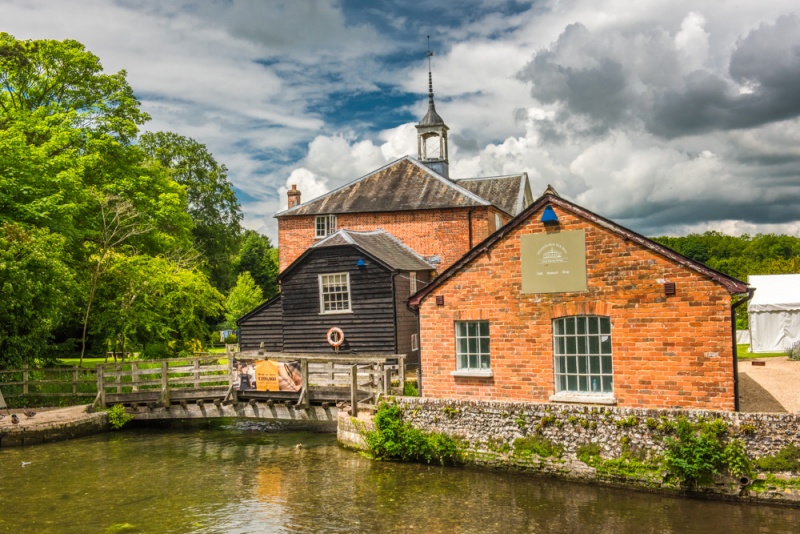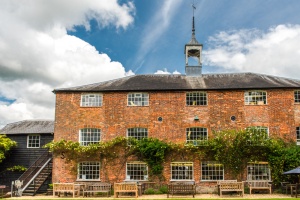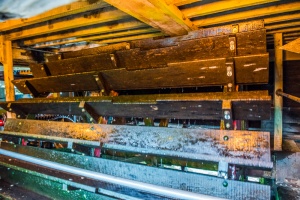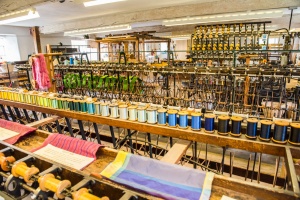
In the historic village of Whitchurch, Hampshire, stands the oldest working silk mill in England still occupying its original buildings. The Whitchurch Silk Mill was established in 1815 and still uses its 19th century machinery to produce silk cloth and garments.
The mill is a wonderful example of industrial heritage, using a water mill on the River Test to drive historic looms and milling machinery. The mill makes bespoke silk fabric used for film and television productions, fashion, and custom interior designs. From the Whitchurch mill, you can follow the seven mile long Mill Trail, taking in five historic mills along the River Test.

History
In 1815 Henry Heyter built a silk mill on land owned by the Dean and Chapter of Winchester Cathedral. The mill was driven by a water wheel and stood two storeys high, with a central access bay. Just two years later the mill was purchased by William Maddick, a successful silk manufacturer from the Spitalfields area of London.
Maddick developed the mill that we see today, employing as many as 80 people to produce fine silk.
In 1844 the mill was sold to Alexander Bannerman and John Spencer, a pair of merchants from Manchester, but the new owners sold it just two years later to the mill manager, William Chappell.
The mill went into a decline in the 1860s when the duty on imported French silk was abolished, making imported silk cheaper than the domestic product. Then a silkworm disease struck, making production difficult. From a high of 80 employees, the mill shrunk to just eight workers by 1901.
By the early 20th century the mill was producing high-quality silk material for Burberry, as well as legal and academic gowns and fashionable silk shirts. During WWII the mill wove silk for insulating electric cables.

In 1985 the Hampshire Buildings Preservation Trust bought the mill and set about restoring the buildings and the milling machinery. In 1990 the mill was opened to the public, and it continues to produce silk using the restored Victorian machinery to this day.
The Waterloo Clock
The mill building is topped by large triangular portico under a striking, slender turret. In the centre of the portico is a large clock. The clock was made in 1815 by the Handley and Moore company of London. It is known as The Waterloo Clock, as it was made and installed in the same year as the Battle of Waterloo.
Handley and Moore were a prestigious company famed for the public clocks used in railway stations, churches, and other public places. From 1866 they enjoyed royal patronage and were allowed to call themselves 'Makers to the Queen'. The silk mill clock has a three foot wide dial and is one of just two made in 1815. It is still largely original and has been operating for over 200 years.

Visiting
The mill is easy to find and is well signposted from surrounding roads. It stands beside the bridge on Winchester Road, on the southern edge of Whitchurch. There is no dedicated parking area; in fact I found parking a bit difficult but managed to find a spot along the road a short walk away.
You enter through the shop, which has a wonderful array of silk products made at the mill, and there is a short introductory video about the history of the mill and how silk is produced, spun, and woven.
You explore the mill by following arrows through the mill buildings, and there are very good information panels explaining each step of the silk production process, from gathering the silk cocoons to winding, warping, and weaving. There is also a display of fine silk garments and cloth made for special occasions, and a very good exhibition on the history of the mill, with stories about the people who worked here that really help make the tour come alive.
I thoroughly enjoyed touring the mill; it is a beautiful historic building in a very picturesque location.
About Whitchurch Silk Mill
Address: 28 Winchester Street,
Whitchurch,
Hampshire,
England, RG28 7AL
Attraction Type: Historic Building - Mill
Location: By the bridge on Winchester Street, easily accessed from the A44 northbound exit to Whitchurch. No onsite parking.
Website: Whitchurch Silk Mill
Email: info@whitchurchsilkmill.org.uk
Location
map
OS: SU462478
Photo Credit: David Ross and Britain Express
HERITAGE
 We've 'tagged' this attraction information to help you find related historic attractions and learn more about major time periods mentioned.
We've 'tagged' this attraction information to help you find related historic attractions and learn more about major time periods mentioned.
Historic Time Periods:
Find other attractions tagged with:
19th century (Time Period) - Victorian (Time Period) -
NEARBY HISTORIC ATTRACTIONS
Heritage Rated from 1- 5 (low to exceptional) on historic interest
Hurstbourne Priors, St Andrew's Church - 1.6 miles (Historic Church) ![]()
Freefolk, St Nicholas Church - 1.6 miles (Historic Church) ![]()
Longparish, St Nicholas Church - 3.4 miles (Historic Church) ![]()
Barton Stacey, All Saints Church - 4.5 miles (Historic Church) ![]()
Wherwell, St Peter & Holy Cross Church - 6.2 miles (Historic Church) ![]()
Chilbolton, St Mary-the-Less Church - 6.3 miles (Historic Church) ![]()
Highclere Castle - 6.8 miles (Historic House) ![]()
Sandham Memorial Chapel - 8 miles (Historic Church) ![]()
Nearest Holiday Cottages to Whitchurch Silk Mill:
Hungerford, Berkshire
Sleeps: 6
Stay from: £607.00 - 3534.00
More self catering near Whitchurch Silk Mill









